Lecture 3: Genome Organization
1/29
There's no tags or description
Looks like no tags are added yet.
Name | Mastery | Learn | Test | Matching | Spaced |
|---|
No study sessions yet.
30 Terms
Genome organization varies in different organisms
2 genome classes
Packing of the eukaryotic genome
Problem
How to fit 2 meters of DNA into a 10um space
Solution
Double-stranded linear DNA packed into chromatin (DNA + histones)
Genomes composed of chromosomes in cells
Chromatin: composed of chromosome DNA and histones
Nucleosomes
Core octamer of histones plus one molecule of the linker
histone.180 bp DNA wound around, left-handed (positive/negative supercoiling??)
left= denature= Negative supercoil
partial digestions of chromosome using DNase reveals nucleosome structure
-isolate chromatin and use DNAase
Histones are small, positively charged proteins
2 types of histones
highly conserved core histones
more variable linker histones
Why are they positively charged???
Bc DNA molecule are negative
Core histones
small, positively-charged, basic proteins
Histones
H2A, H2B, H3, H4
Rich in arginine and lysine
bc epigenetic modification, each are highly modified in body, and positively charged
146 bp of negatively charged DNA wraps nearly twice around the positively charged octamers

Linker histones
larger than core histones, positively-charged, basic proteins
Histones H1, H5, H1’,etc (NO REMEMBER)
between core octamers

Some cells do not possess histones
Protamine
Sperm DNA compacted with basic proteins
N and C terminal so of histones play critical roles
Carboxyl (C) terminal end
• Extended histone-fold domain
• Histone-histone interactions
• Histone-DNA interactionsAmino (N) terminal charged “tails”
• Lysine-richhighly modified
• Sites of many post-translational modifications
Further packaging of DNA involves loop domains
Insight into loop structure comes from studies of lampbrush chromosomes in amphibian oocytes
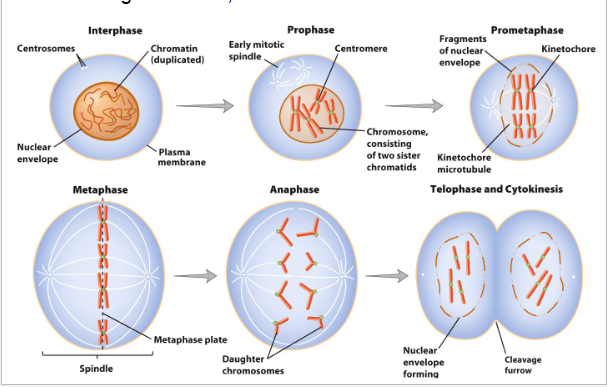
Fully condensed: metaphase chromosomes
packing ration of 10,000 fold
The centromere provides the site of attachment for segregation during cell division
A fully condensed metaphase chromosome consists of two sister chromatids connected at the centromere.
From the centromere, the kinetochore captures spindle microtubules, which ensure that sister chromatid
telomere→ at end

Other chromosome elements
1 or + origins of replication
telomere at each end
Autosomes and sex chromosomes
Karyotype: the number, size, and shape of the
chromosomesChromosomes are classified as sex chromosomes or
autosomesXX (female)
XY (male)
Why isn’t the introduced foreign plasmid DNA degraded by
a bacterial restriction-modification system?
Organization and expression of the genetic material
Heterochromatin: chromatin that is condensed a suppresses transcription
Euchromatin: chromatin that is more open and allows for gene activation
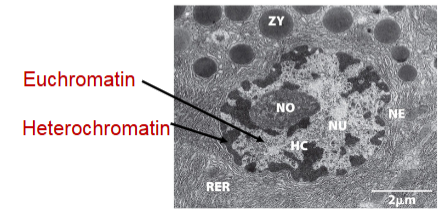
Eukaryotic gene expression is regulated at three levels
DNA sequence: DNA-binding proteins associate with regulatory elements in the DNA.
Chromatin structure: changes in the way the DNA is wrapped around the histones.
Nuclear architecture: positioning of chromosomes in “territories” in the nucleus.
The majority of the eukaryotic genome is noncoding
Most genomic DNA consists of various classes of repetitive DNA sequences
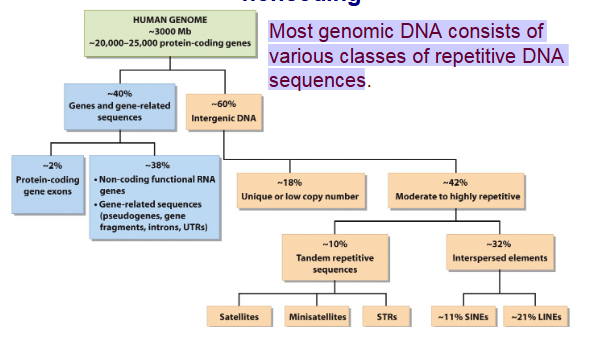
Organization of the human genome
Less than 40% of the human genome is comprised of genes and gene-related sequences
Repetitive DNA sequences are divided into two major classes
Interspersed elements (primarily transposable elements)
genome wide repeats made of degenerate copies of transposable elements
Short interspersed nuclear elements (SINEs)
Long interspersed nuclear elements (LINEs)
EX: AGAG………GAGA (has gaps)
Tandem repetitive elements (Arranged in arrays with variable numbers of repeats)
3 subdivisions based on length
Satellite DNA (1.69 density), (reg DNA 1.7)
Very highly repetitive DNA
Buoyant density during density gradient centrifugation differs from that of the bulk of the DNA.
lighter density bv they have a lot of AT (GC is heavier and more density)
Minisatellites
Short tandem repeats (STRs)
EX: AGAGAGAGAGAG (all right next to each other)
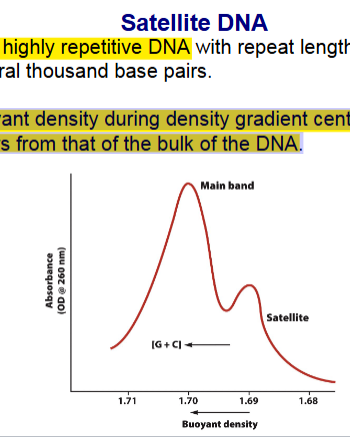
Lateral gene transfer in the eukaryotic genome (Graffith experiment)
Lateral or horizontal transfer -> the transfer of DNA between two different species, especially distantly related species.
Important mechanism for bacterial evolution; in particular, through movement of transposable elements.
Organelle genomes reflect an endosymbiont origin
Mitochondria and chloroplast contain own genetic information (CpDNA & mtDNA)
Endosymbiont Hypothesis: both organelles derived from primitive, free-living, bacterial- like organisms
Intercompartmental DNA transfer
a type of lateral gene transfer
associated with gradual loss of endosymbiont’s independence on the path to becoming an organelle
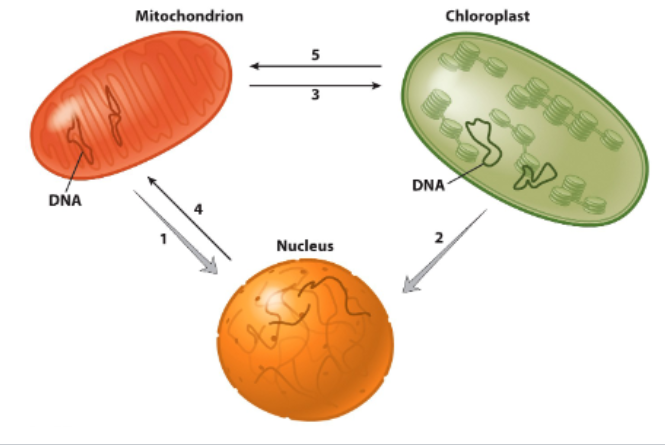
Eukaryotic genomes are mosaic
made of complicated evolutionary history
most human genes transferred from endosymbiont
proteins in nuclear envelope made of genes of both archael and bacterial origin
Prokaryotic and viral genome organization
bacterial genome organization
single, covalently closed circular DNA molecule
nucleoid: condensation involving histone-like proteins into a structure
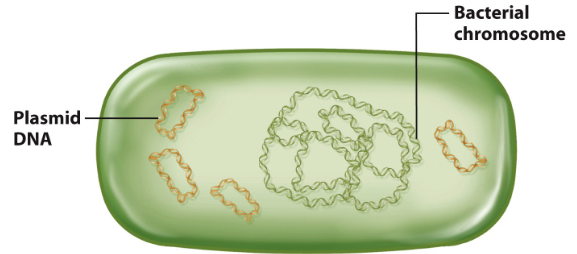
Histone-like or nucleoid-associated proteins
• HU (heat-unstable protein)
• IHF (integration host factor)
• HNS (heat-stable nucleoid structuring)
• SMC (structural maintenance of chromosomes)
lateral gene transfer in bacteria
source of genetic material for bacteria
allows for rapid response to changing environments
Plasmid DNA
• Small, double-stranded circular or linear DNA molecules.
• Carried by bacteria, some fungi, and some higher plants.
• Extrachromosomal, independent, and self-replicating.
• Carriers of resistance to antibiotics.(gene in plasmid tht creates protein that resists antibiotics)
• Vehicles for genetic engineering.
independent and works seperate from baterial chromosomes
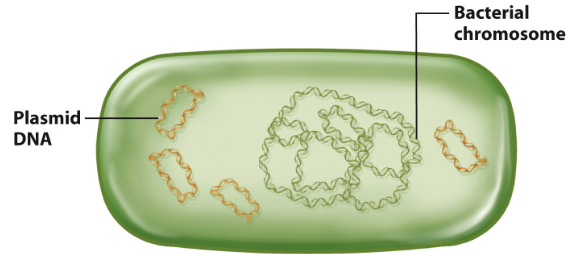
Archael genome organization
One double-stranded circular DNA molecule (0.5 to 5.5 Mb)
Some archaea have two distinct histones
Viral genome organization
Bacteriophages (Prokaryotic viruses
Genome typically consists of a single DNA molecule, largely devoid of associated proteins
Mammalian DNA viruses
infect mammalian cells and make use of host machinery for their replication and in Varity of diverse forms